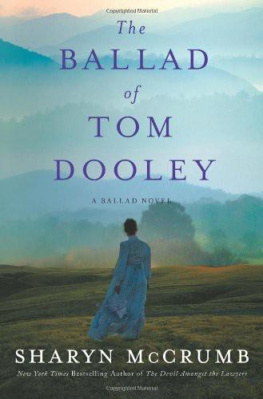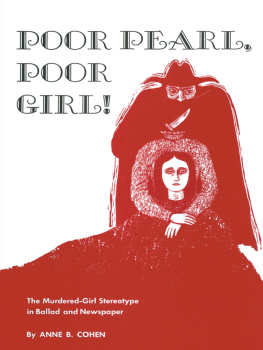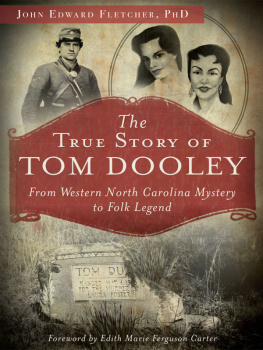
Sharyn McCrumb is the author of The Rosewood Casket, She Walks These Hills, and many other acclaimed novels. Her books have been named Notable Books of the Year by The New York Times and the Los Angeles Times . She was named a Virginia Woman of History for achievement in literature in 2008. She lives and writes in the Virginia Blue Ridge, less than a hundred miles from where her family settled in 1790 in the Smoky Mountains that divide North Carolina and Tennessee.
For more information, please visit her Web site at www.sharynmccrumb.com.
ACKNOWLEDGMENTS
The story of Tom Dula, Ann Melton, and Laura Foster has been a carefully tended legend in Wilkes County, North Carolina, for well over a century. To sort out the real story at the heart of the folk song, I needed to go to the source.
Appalachian State University historian John Foster West wrote two nonfiction accounts of the Tom Dula story, and I consulted these books as the basis for further investigation. Although Wests account of the case was thorough and meticulous, his research, conducted more than thirty years ago, did not have the benefit of the resources that modern technology has made available and accessible to scholars today. When I began to study Mr. Wests scenario, I felt that the facts did not add up to a satisfactory explanation, and I went back to the original trial transcripts and began to put together a theory that would make sense of the case.
Ever since I first began writing novels about the history and folklore of the Southern mountains, people have been asking me to tell the story of Tom Dula, but I had thought that the story was too sordid and unexceptional to make a good novel. I revised my opinion in 2005 when Cara Modisett, editor of Blue Ridge Country magazine, asked me to research the legend for an article for the magazine. One summer day, armed with maps and a copy of John Foster Wests book, I traveled to Wilkes County, North Carolina, with my old friend David McPherson, and together we tried to make sense of that long-ago incident. Thank you, David, for listening, and for agreeing with me that what we had been told wasnt making sense.
A few miles from where it all happened, Edith Ferguson Carter has kept a Tom Dooley museum within the grounds of her Whippoorwill Academy for the past half century. Besides preserving artifacts from the casea lock of Laura Fosters hair, Tom Dulas fiddle, and his original headstoneMs. Carter also keeps track of the genealogical records, and her museum is a repository for all the stories that have grown up around the case. It was to the Whippoorwill Academy that I went when I began to study the case, and I owe a great deal of thanks to Edith Ferguson Carter for her time, her generosity, and her patience. The Zebulon Vance part of the story was enriched by the encouragement and assistance of David Tate and the staff of the Zebulon Vance Birthplace in Reems Creek, Madison County, North Carolina.
Three scholars at Wilkes Community College shared their expertise and gave me the pleasure of their company in the course of my research. Professor Julie Mullis, chairman of WCCs Department of Arts & Communication, who teaches a course on the Tom Dula story, led the expedition to Ferguson one bright fall day, and we visited the places where the Dula, Foster, and Melton houses once stood. We photographed the Bates place, climbed Laura Foster Ridge, where the body was originally interred, and scaled a high fence in order to get in to the pasture that contains the grave of Laura Foster. WCC Research Librarian Christy Earp searched genealogical records and census data to pinpoint the residences of the Andersons, the Scotts, etc., and to track the people in the case through the years. The most exciting moment of the research was when I asked Christy to locate:
a light-skinned man of color (mulatto), probably named John Anderson;
in 1866 he would be younger than thirty, probably early twenties in age;
he would live either close to Lauras home in Germans Hill or close to the Bates place.
Within hours, Christy Earp had found him in the 1870 Caldwell County census. John Anderson, mulatto, was twenty-onethe same age as Laurain 1866, and at the time he lived on the Anderson farm (Elizas, with her widowed mother and her brother Wash, who was Toms best friend). When we discovered that the Anderson farm adjoined the Bates place, I got chills. We knew we had found a crucial piece of evidence.
WCC-Ashe professor Shannan Roark was my connection to the experts in Wilkes County, and she went along on our trek to Ferguson, photographing sites and measuring the distance from one place to another, as we tried to make sense of what really happened.
Mr. Zelotese Walsh of Wilkes County has amassed detailed genealogical records of Wilkes Countys people, and he sorted through the Foster begats for me, in an attempt to pinpoint the lineage of Pauline Foster.
Dr. Randy Joyner of Wilkes County, a descendant of the Andersons, checked family records for me in connection with Wash and Eliza Anderson, provided me with a number of physical details about the county that helped me to construct the narrative, and took me to the grave of Tom Dula. My thanks, too, to genealogist Andy Pilley for his help with the background and photographs relating to the people in the story and to attorney David Hood of Hickory, North Carolina.
Michael Hardy, North Carolinas Historian of the Year for 2011, is an author of North Carolina regimental histories and an expert on the Civil War. It was he who tracked down the war records of Thomas Dula and James Melton, discovering connections between them that had not previously come to light.
My thanks to my son Spencer McCrumb who spent a morning at the North Carolina Archives in Raleigh, obtaining for me the trial transcripts and any relevant documents concerning the case of Tom Dula.
When I realized that the Tom Dula story was an Appalachian parallel to Wuthering Heights, Elizabeth Baird Hardy, a Western North Carolina English professor and author, heard me out, leaping to the connections as fast as I did, and we had a wonderful time finding a literary template for this most famous of mountain legends. I am grateful for her encouragement and her friendship.
The psychological aspects of the story were important. While most people have dismissed the servant girl as a minor character in this incident, I concluded that the catalyst in this story was Pauline Foster, and that her malice and discontent caused the deaths of Laura Foster and Tom Dula. Ann Meltons narcissism made her indifferent to the suffering of other people. To understand Paulines sociopathic disorder and Anns narcissism, I was fortunate to receive guidance from Forensic and Consulting Psychologist Dr. Charlton S. Stanley of Tennessee, who helped me understand the psychology of these two pivotal characters, and to determine how their mind-sets would be manifested in their behavior. Dr. Martin E. Olsen, director of OB/GYN at East Tennessee State University, helped me to determine whether an autopsy would have showed if Laura Foster was pregnant.
It took many hours of talking to a great many people to enable me to sort out the facts and the personalities that shaped this story, and I am grateful to everyone who listened.
Also by Sharyn McCrumb
THE BALLAD NOVELS
If Ever I Return, Pretty Peggy-O
The Hangmans Beautiful Daughter
She Walks These Hills
The Rosewood Casket
The Ballad of Frankie Silver
The Songcatcher
Ghost Riders
The Devil Amongst the Lawyers
THE NASCAR NOVELS
St. Dale
Once Around the Track
Faster Pastor (with Adam Edwards)
Next page




